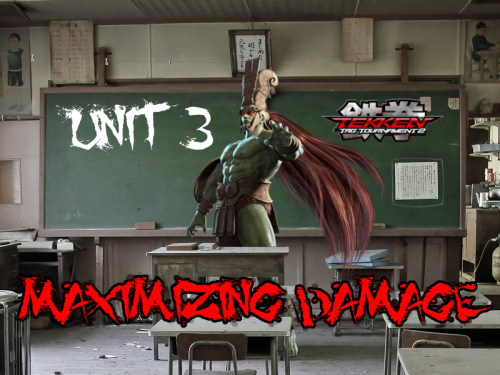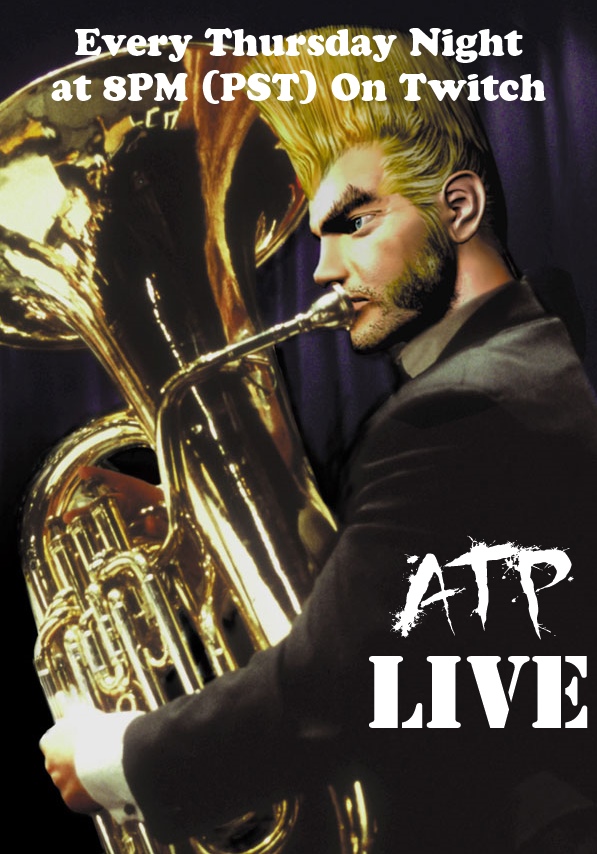TTT2 Beginner's Guide - Unit 3: Maximizing Damage
 AAK ON
AAK ON  Friday, September 7, 2012 at 10:38AM
Friday, September 7, 2012 at 10:38AM 
Now you understand the different ways of having your opponent's healthbar depleted. BUT in a fighting game once you land an attack you automatically open yourself up to another world of possibilities and actions you can take advantage of get that win against your adversary. This section will outline what certain juggle starters look like, status effects on your opponent and what they imply, followed by exploring what you can fit into your juggles once you land them.
I. Juggle Starters
Juggles are the big bills of currency for damage in Tekken. The fundamentals base around moving/spacing and poking, punishing, and waking up properly (discussed later on). But when the opportunity arrives, you launch your opponent immediately. There are A TON of ways to launch your opponent and I'll try my best to organize and describe all of them to you. There are no official names for a bunch of these launcher other than "juggle launcher" so I'm going to be a little creative here.
- Regular Knockdown Juggles
- Orthodox Juggle Starter - (Asuka f+2) - This is the most common juggle starter in Tekken where the opponent is uppercutted upward with their body rougly horizontal with the floor and his/her head away from allowing you to easily continue the juggle with almost any move in the command list
- Upward Thrust - (Lars f,f+2) - Here, the move thrusts the opponent to the sky from a lower part of the body making the opponent perfectly horizontal but instead with his/her head toward you making the hitbox for continuing the juggle more tricky
- Wild Flip - (Ling AOP u/f+3) - The opponent starts backflipping wildly, these juggle starters require you to quickly jab or bound (explained later) since they will fall to the ground pretty fast. Other examples are Alisa's u/f+4 or Feng's d/f+3.
- Projectile Propulsion - (Devil Jin WS+2) - The impact of your strike will catapult your opponent in projectile motion a far distance requiring you to dash far to continue your juggle, but pretty damn awesome looking.
- Half Barrel Roll - (Eddy/Christie SS+3+4) - Here the sideways-esque attack will launch the opponent in a hybrid between a flip and a cartwheel but it never finishes and just leaves the opponent dangling in the air waiting for you to continue juggling them.
- Skyward Eruption - (Jack f,F+2 o) - This just looks like a Volcano Eruption. It's a massive strike that causes the opponent to spiral miles high in the air before falling, they go so high that when they fall they even bounce up again giving you plenty of time to add any juicy combo filler.
- Light Projectile Propulsion - (Law d+2,3) - Little bit like Devil Jin's WS+2 but in a much lower pronounced magnitude, there is no need for dashing forward. the next combo followup just needs to be executed then and their or the juggle will be missed.
- Backflip - (Lei f+3,1,b+2) - Pretty self explanatory where the opponent just gets knocked into the air where they're flipped and continuing the juggle will put the opponent in a similar orientation to the upward thrust.

- Low Juggle Starters
- Flair Trip - (Yoshimitsu FC d/f+1) - Calling it the flair trip because it reminds me of the flair trick in BMX stunts, it twirls them around and half flips them simultaneously giving you enough time to juggle successfully.
- Half Cartwheel - (Lars d/b+4) - This trip will fire your opponents legs into the foreground until their head hits the ground and in that animation they can be juggled
- Multi Cartwheel - (Paul qcf+1+2) - Usually a power low that will make them spin 1.5 times in a cartwheel motion which likewise gives you the mos time for a juggle filler and hence leads to the most juggle damage.
- Split Trip - (Zafina TNT d+1+2) - This isn't usually a juggle starter but in many cases it is where the opponents legs get split and they end up falling. Zafina's TNT d+1+2 is quick enough for her to get moves from her Mantis stance

- Bounce Juggle Starters
- Regular Bounce - (Lars u/f+4) - Usually a visceral overhead strike that smashes the opponent to the ground and then the momentum just causes them to bounce up high in the air to continue the juggle normally
- Bounce to Flip - (Zafina SCR 1+2) - Just like a bounce, but even more visceral where they flip up while bouncing but it's harder to get good damage due to the horizontal orientation with their head facing you

- Knockdown Recoil Juggles
A very specific move that forcefully knockdowns your opponent with quick recovery, and the knockdown animation will have a portion where the legs recoil, and during that window you can land a clean hit for a specific move as seen below:
- Grapple Juggle Starters
A lot of grapples can juggle your opponent, it's relatively self explanatory as seen below:
- Character Specific
Other than that, there are always character specific tools where certain characters recover a lot faster and can turn a knockdown animation that isn't normally a juggle starter, into a legitimate juggle starter as seen below:
II. Stuns
Stuns are another fascinating part of Tekken. With such an abundance of moves it's customary that it should have a magnitude of hit responses to accommodate all of them. When your opponent is stunned it is always an opportunity to unleash free damage upon them. Here the various stuns that certain moves inflict will be discussed.
- Breakable Stuns
- Double Overstun - (Nina d/f+1+2) - A gut stun that has the opponent holding their stomachs before collapsing on the ground. It lasts for a very long time and gives you ample time launch the opponent naturally. to break this you have to tap f right after it hits you.
- Stagger Hit - (Nina b+4) - A snappy strike to the face that will cause the opponent to stagger and real back from the attack slightly. Moves that inflict this stun usually have quick recovery allowing you to land a free juggle if the stagger isn't broken by holding D.
- Flop Stun - (Miguel d/f+3,2) - Another quick strike to the upper body which will cause your opponent to lose balance and touch the floor momentarily before regaining composure and returning to neutral position. That phase of when he/she gets back up is a perfect opportunity for free damage. It can only be avoided if they tech by tapping 1 or 3 right when they touch the floor during the flop stun.

- Crumple Fall
Crumple Falls always entail situations where the attack causes the opponent to stand upright for one second before crumbling into the ground like a ragdoll, but the key identity of a crumple fall is the moment of standing upright before falling.
- Crumple Fall Stun
Crumple Fall Stuns involves the opponent getting hit by an attack inducing a short state of grogginess before they end up staggering to the floor backward giving the opponent enough time to dash forward and start a juggle.
- Crumple Stun
Crumple Stun harbor all of the other possible stuns that have the opponent falling down which isn't a staggered/groggy fall nor an upright figure crumbling down.
- Block Stun
The block stun is simply the stun that is inflicted on opponent by blocking their damaging low attack (usually a low attack which initiates a juggle). Once it is successfully blocked they'll be momentarily stunned giving you a guaranteed follow up. These stuns are usually very long and give you enough advantage to even launch your opponent for a lot of juicy damage. This exemplifies the danger of using too many low moves. Even if the low move is safe on block, they can still be low parried (explained later)
III. Minor Stuns
Minor stuns are basically move properties that inflict a certain painful animation but does not lead to any damage. This section was by far the most difficult to come up with a format to explain because there are just so damn many but here is the best way I could explain it.
- Minor Stuns
There are SO MANY types of minor stuns that I couldn't keep track of them, every time I thought I figured them out another one get noticed in some match video. Just to give you an example:
However, there are a group of specific minor stuns that could be classified. - Orientation Stun
Orientation stuns are move properties that can help dictate the flow of the match for you. The most common one is the OC which forces your opponent to crouch, therefore you have situations where the only available moveset your opponent will have in that position is a WS (while standing) move or a crouching move which is severely limited since those moves are usually linear. They have to return to the neutral position as fast as they can but it's not especially easy, so it's always a good idea to keep the pressure on or just sidestep their oncoming retaliation.- OB - (Julia 2~u_b) - Force opponent's back to face you
- OC (Ling d+1) - Force opponent to crouch
- OS (Ling f,f+3) - Force opponent's side to face you

- Using Minor Stuns Mid-String (See String Section)
Noticing which moves cause minor stuns can be useful in visually figuring out which moves are NC of NCc. If the first or any preceding command in your string will cause a minor stun, the next will be guaranteed as a natural combo as seen here:
- Guard Stun
Guard stuns are another type of move property to dictate the flow of the match for you. Guard stuns are inflicted when your opponent block a particularly hail mary of an attack that puts them into a guard stun. During this guard stun they can't do anything except keep blocking which shuts down a lot of options your opponent has and allows you to keep on applying pressure.
IV. Bound
This is a new system introduced in Tekken 6 where certain spike moves in each character’s movelist could be used to re-bound the opponent and continue the juggle with moves that might have previously needed less start up frames.
As you saw, after the bound, Baek could dash forward and end the combo with a tsunami kick after the previous barrage of juggle filler that wasn't possible previously in the series. This will lay the foundation for the Tag Assault we’ll see later on. And you CAN’T bound more than once in a combo except for certain situation which will be described later on.
V. Walls
Walls in Tekken work like any other 3D fighting game like Soul Calibur, Dead or Alive, and Virtua Fighter. It's a dead end for where you or your opponent will have to stop turtling and do some risky maneuvers to have a better vantage point. There is a key difference in Tekken than say Virtua Fighter. Earlier in Unit 1, sidestepping was discussed how it evades linear moves. However, at a wall, you can't sidestep towards the direction of the wall since your hitbox will prevent you from evading the incomming hurtbox from your opponent. That's another thing to take into account when a wall is to your side. But once a juggled opponent reaches a wall (which is the most common scenario) you will be able to finish that combo with some very juicy damage.
This is going to be tricky to explain but IMO the best way to simplify wall combo's is to divide them into low wall splats, high wall splats, and wall stuns:
- Low Wall Splat - The moment your opponent hits a wall while they were juggled. This gives you the opportunity to hit moves and strings that you normally couldn't during regular juggles which can lead to massive damage. Usually players conserve their bound attack until they reach the wall which usually yields in better results.
- High Wall Splat - This is the exact same thing as a low wall splat except that it happens when your opponent hits the wall during the juggle when they are significantly higher in the air rather than parallel to you. You can basically input an extra attack before continuing your stable low wall splat combo's.
- Wall Stun - A wall stun happens when you manage to unleash a far knockdown move to your opponent while their back is to the wall leaving them in a stunned wall position at the wall. What is unique about this command is how you can lightly wait for the opponent to forward a little bit and do a mini-juggle before they end up returning to the wall but this time in a form of a low wall splat.
All of this can be observed with the gif below:
The Wall also provides an offensive option to anyone trapped by it through a wall jump done by b,b,u/b:

With this you should all have an idea of how to use the mechanics and environment available to you to get the most out of a launcher or stun that you land. And even if you hit your opponent in a stun that isn't a launcher, you could still get free damage out of it by hit-confirming it with a potential string ender from that move. The next unit will be covering up all the other core mechanics present in Tekken Tag Tournament 2 and includes one of the most important one: Wakeup and Okizeme.
 guide,
guide,  tutorial in
tutorial in  Avoiding The Puddle,
Avoiding The Puddle,  TTT2,
TTT2,  Tekken Tag Tournament 2,
Tekken Tag Tournament 2,  Video,
Video,  combo,
combo,  news,
news,  strategy,
strategy,  tekken,
tekken,  tournaments
tournaments 










Reader Comments (6)
Good stuff AAK!
I really appreciate all the work that went into this, inagine all the videos he had to watch and edit! Amazing!
I tried to find some info about the stuns and your guide was very useful info with gifs.
AAK Thx a lot!!!
heydywale e3d3fd1842 https://www.nflfriends.com/gamagmostsnip
heydywale e3d3fd1842 https://www.nflfriends.com/gamagmostsnip
heydywale e3d3fd1842 https://www.nflfriends.com/gamagmostsnip